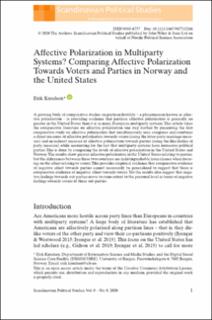| dc.contributor.author | Knudsen, Erik | |
| dc.date.accessioned | 2021-05-28T08:44:39Z | |
| dc.date.available | 2021-05-28T08:44:39Z | |
| dc.date.created | 2021-01-19T12:14:53Z | |
| dc.date.issued | 2021 | |
| dc.identifier.issn | 0080-6757 | |
| dc.identifier.uri | https://hdl.handle.net/11250/2756804 | |
| dc.description.abstract | A growing body of comparative studies on partisan hostility – a phenomenon known as affective polarization – is providing evidence that partisan affective polarization is generally no greater in the United States than it is in many European multiparty systems. This article takes the comparative literature on affective polarization one step further by presenting the first comparative study on affective polarization that simultaneously uses, compares and combines a direct measure of affective polarization towards voters (using the inter-party marriage measure) and an indirect measure of affective polarization towards parties (using the like/dislike of party measure) while accounting for the fact that multiparty systems have numerous political parties. This is done by comparing the levels of affective polarization in the United States and Norway. The results show greater affective polarization in the United States relating to parties, but the differences between these two countries are indistinguishable from chance when focusing on the affect relating to voters. This provides empirical evidence that comparative evidence of negative affect towards parties cannot necessarily be generalized to suggest that there is comparative evidence of negative affect towards voters. Yet the results also suggest that negative feelings towards out-parties move to some extent to the personal level in terms of negative feelings towards voters of these out-parties. | en_US |
| dc.language.iso | eng | en_US |
| dc.publisher | Wiley | en_US |
| dc.rights | Navngivelse 4.0 Internasjonal | * |
| dc.rights.uri | http://creativecommons.org/licenses/by/4.0/deed.no | * |
| dc.title | Affective Polarization in Multiparty Systems? Comparing Affective Polarization Towards Voters and Parties in Norway and the United States | en_US |
| dc.type | Journal article | en_US |
| dc.type | Peer reviewed | en_US |
| dc.description.version | publishedVersion | en_US |
| dc.rights.holder | Copyright 2020 The Authors | en_US |
| cristin.ispublished | true | |
| cristin.fulltext | original | |
| cristin.qualitycode | 1 | |
| dc.identifier.doi | https://doi.org/10.1111/1467-9477.12186 | |
| dc.identifier.cristin | 1874226 | |
| dc.source.journal | Scandinavian Political Studies | en_US |
| dc.source.pagenumber | 34-44 | en_US |
| dc.identifier.citation | Scandinavian Political Studies. 2021, 44(1), 34-44 | en_US |
| dc.source.volume | 44 | en_US |
| dc.source.issue | 1 | en_US |

